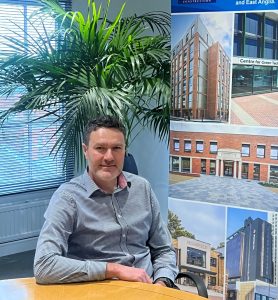
Clegg Construction appoints new commercial manager
Contractor Clegg Construction has strengthened its team with the appointment of a new commercial manager. Andy Bore will be the commercial lead on the Midway Karparc project – an innovative scheme in Newcastle-under-Lyme to redevelop a 1960s former multi-storey car park into apartments which is being undertaken by Clegg Construction for Capital & Centric. He will also provide commercial and contractual support across the wider business and assist with the development, training and mentoring of the commercial team. With 24 years of working in the construction sector for companies such as Interserve, Kier, Thomas Vale Construction, nmcn and most recently GF Tomlinson, Andy brings a wealth of experience to the role. Clegg Construction Commercial Director Dan Manley said: “We are very pleased to welcome Andy to the Clegg Construction team. His extensive experience and proven track record in the industry will be an asset to our business. “Andy possesses expertise that I am sure will bring a positive impact, not only to the Midway Karparc project but across our wider operations as we continue to deliver successful developments for our public and private sector clients.” Andy, has worked on a wide range of schemes – both new build and refurbishment – including schools, shopping centres, a leisure centre and swimming pool, office block, student accommodation, high end housing, bio mass facility, heritage projects, and a few blue light schemes. Andy said: “I am excited to have started a new role as commercial manager at Clegg Construction – bringing my experience and expertise to the company at an exciting time when there is much in the pipeline to look forward to and celebrate.” With its headquarters in the Lace Market, Nottingham, Clegg Construction is a Midlands, East Anglia, and Yorkshire-based construction firm specialising in the delivery of public and private sector projects. The company works with organisations of all sizes and specialities across a comprehensive range of sectors. For more information visit www.cleggconstruction.co.uk Building, Design & Construction Magazine | The Choice of Industry Professionals

McLaren Construction Midlands and North raises over £5,000 for The Lighthouse Club and Motor Neurone Disease Association
McLaren Construction Midlands and North is proud to announce that its annual charity fundraising efforts have raised £5,271.25, supporting this year’s chosen charities: The Lighthouse Club – the construction industry charity, and the Motor Neurone Disease Association (MNDA). The fundraising total includes £4,345.00 raised through events and donations including Christmas Jumper Day, plus an additional £926.25 through Gift Aid. The Midlands and North team have led a range of fundraising activities across the region this year, supported by McLaren colleagues, supply chain partners, subcontractors and external businesses. A key highlight of the fundraising programme was a raffle supported by the generous donation of prizes from McLaren’s supply chain and partners. Contributions included a Sainsbury’s voucher from EH Smiths, four Aston Villa tickets donated by DP Interiors, two Liverpool FC tickets from Cara Brickwork, an iPad from Taurus Electrical, a Celtic Manor stay from Oakwood, a Harrods hamper from Grimes Finishings, and a Coventry hotel stay from Village Hotels. They also included an afternoon tea experience from IHG, a £250 cash donation from MJS, breakfast and cocktails from Albert’s Schloss, a gift card from Fazenda, a meal and cocktails for two from Revolution, a television donated by Miles, and significant £1,000 cash donations from both McCoys and MPB. Luke Arnold, Regional Director of McLaren Construction Midlands and North, said: “A big thank you to Lucy Cramp, Kath Sheppard and Tina Shelton, for all their efforts working tirelessly to bring all of this together, a lot of work goes into this behind the scenes to make this possible and improving the cash raised year on year!” Gary Cramp, Managing Director of McLaren Construction Midlands and North, said: “We are incredibly proud of the teamwork, generosity and community spirit shown across our Midlands and North region. Supporting The Lighthouse Club and the Motor Neurone Disease Association is deeply important to us, and reaching this fundraising milestone reflects the dedication of our people and our partners. A huge thank you to everyone who contributed.” Building, Design & Construction Magazine | The Choice of Industry Professionals

Whitbread wraps up 2025 with planning consent at Dorset House, SE1
Planning permission for the conversion of the 90,000 sq ft office brings hub by Premier Inn a step closer to London’s World-Famous South Bank Whitbread, the parent company to Premier Inn, the UK’s largest hotel business, has successfully secured planning permission to convert Dorset House, a former office building on Stamford Street in Southwark (SE1), into a 421-key hub by Premier Inn. The permission rounds off an especially active 2025 for the business in Central London where it has acquired four development sites for its Premier Inn and hub by Premier Inn brands since January 2025. Collectively, the four locations add close to 1,000 bedrooms – and more than 262,000 sq ft of development space – into Whitbread’s secured development pipeline in the capital. Dorset House brings the hub by Premier Inn brand south of the River Thames for the very first time at a location that boasts Waterloo Station, Blackfriars Station, London’s South Bank and the Royal Festival Hall within a ten-minute walking distance. Whitbread acquired the 90,000 sq ft building freehold in May [2025] and quickly began conversations with Southwark Council on the change of use of the nine-storey vacant office into a hub by Premier Inn hotel. The intention is to add the compact hub bedrooms within the existing floorplate and introduce a new hotel entrance on Stamford Street, with the basement-level F&B space visible through cut-out concrete sections on the ground-floor. Construction work is expected to begin in the second half of 2026 with a target date for opening in summer 2028. Jonathan Langdon, Senior Acquisition Manager for Whitbread, said: “Whitbread’s reliable and affordable hotels are ingrained in London life and we’re taking full advantage of opportunities to expand our network further for our guests. “The buildings we have acquired in 2025 bring four outstanding hotel locations into our secured pipeline in places where we are either not yet represented or are responding to strong, year-round demand from our customers. “All four acquisitions demonstrate Whitbread’s ability to spot and convert excellent opportunities to grow our business, deploy capital strategically, and work through planning risks to successfully grow our estate. “Achieving planning permission at Dorset House rounds off an especially active period for Whitbread’s Central London team in 2025, and we are moving quickly to progress our pipeline hotels into construction and onto trading as soon as possible.” Reflecting wider changes in the demand for office properties across the UK, all of Whitbread’s property acquisitions in Central London are office-to-hotel conversions. They include: Collectively the acquisitions total more than £100 million of direct investment. All the new hotels will be powered solely by electricity generated from renewable sources in line with Whitbread’s sustainability programme, Force For Good. Whitbread’s London hotels represent 18% of the company’s c. 86,000 bedroom-strong network in the UK & Ireland and an important growth market for both brands as the company works to expand its hotel estate by 45% to a long-term potential target of 125,000 UK&I rooms. Building, Design & Construction Magazine | The Choice of Industry Professionals

McLaren Construction Midlands and North appointed to deliver Upper Brook Street student scheme in Manchester
McLaren Property, the leading residential and student accommodation developer, have formally appointed McLaren Construction Midlands and North as main contractor for the landmark Upper Brook Street student accommodation development in Manchester. The project marks the second major scheme in the city where the two McLaren divisions are collaborating, following their successful partnership on St Gabriels Court. Early works have been progressing at pace, with both tower cranes now fully installed onsite. Ground clearance and preparation works are complete, alongside the installation of temporary site facilities. Piling has also concluded with 219 piles installed and concrete bases formed to support the two new residential buildings and cranes. The team aims to have slip-form rigs assembled before the Christmas period, enabling the concrete frame to commence early in the new year. McLaren Property’s £160m Upper Brook Street development will be forward funded by L&G, a leading direct investor, lender, developer, and operator in residential real estate, with the partnership delivering the purpose-built student accommodation scheme, comprising c.272,854 sq ft across two buildings of 9-storey and 23-storeys, totalling 737 student bedspaces (288 studios and 449 cluster bedrooms) along with a range of shared amenities including a gym, fitness studio and collaborative study and social spaces. Upper Brook Street is just south-east of Manchester city centre, near the Russell Group’s University of Manchester and is part of the Oxford Road Corridor. It is widely acknowledged as a growing hub for students and research. The new student accommodation building will include a community facility, café and new accessible public realm with new trees, and a commitment to achieve high levels of sustainability to include BREEAM excellent, EPC A and Platinum Wired Score ratings. Extensive hard and soft landscaping will create new public realm for residents and the surrounding community. Modern methods of construction will play a central role in the build, and the project incorporates a full concrete frame with fully unitised prefabricated concrete panels, complete with integrated brickwork and windows to drive efficiency and quality. Bathroom pods manufactured off-site by Walker Modular will further streamline delivery. The project is targeting BREEAM Excellent and an EPC A rating, with completion set in time for the 2028 academic year. Alongside its technical and environmental ambitions, the scheme places strong emphasis on social value and the project team is partnering with local community groups and the Salvation Army to deliver initiatives that exceed contractual social value commitments. Luke Arnold, Regional Director at McLaren Construction Midlands and North, said: “We are delighted to be appointed to deliver this important scheme in the heart of Manchester. Upper Brook Street represents not only a significant investment in the city’s student living offer but also an opportunity to showcase high-quality construction, modern methods of delivery, and meaningful social value.” David Atherton, Divisional Managing Director at McLaren Property, said: “This is the second project we are delivering alongside McLaren Construction in Manchester. We are excited to bring forward another best-in-class student accommodation development, adding to our strong pipeline across the UK. As we move into the delivery phrase, all those involved in the project are fully focused on completing an exemplary building, one that the McLaren teams and the city can be very proud of.” Building, Design & Construction Magazine | The Choice of Industry Professionals

Arlington Real Estate and Homes England Submit Plans for £400m West Hartford Park Employment Hub
A major planning application has been lodged for West Hartford Park, a 126-acre industrial and commercial scheme near Cramlington that could deliver more than one million square feet of employment space and create around 2,000 jobs in Northumberland. The outline masterplan has been submitted jointly by Arlington Real Estate and Homes England, marking a significant step forward for one of the largest strategic development opportunities in the region. Located just minutes from the deep-sea Port of Blyth, the proposed development is designed to support the port’s continued expansion and forms a key component of the Energy Central Partnership. This initiative positions South East Northumberland as a national centre for offshore and renewable energy, clean technology, advanced manufacturing and AI-driven industries. The Port of Blyth, home to ORE Catapult’s world-leading testing facilities, is working closely with Arlington Real Estate and Homes England to maximise the economic potential of the scheme and attract major occupiers from both the UK and overseas. Despite the marketing campaign not yet being launched, the project has already generated strong interest from several large-scale industrial and logistics businesses. If approved, West Hartford Park is expected to generate over £400m of investment for the North East economy and deliver thousands of high-quality jobs, providing a major boost to local supply chains and long-term regional growth. Dean Cook, managing director of Arlington Real Estate, said submitting the application marks an important milestone in unlocking the site’s full potential. He highlighted that West Hartford Park is the only location in the region capable of accommodating development at this scale, offering the power, infrastructure and connectivity required by major occupiers. Cook added that the project will directly support the growth of offshore and renewable energy, advanced manufacturing, logistics and AI sectors. Councillor Richard Wearmouth, deputy leader of Northumberland County Council and cabinet member for business, growth and regeneration, welcomed the news, describing West Hartford Park as the county’s most significant remaining employment allocation in the current local plan. He said maximising its potential is crucial to attracting future investment and creating new job opportunities in the area. Martin Lawlor OBE, chief executive of the Port of Blyth, added that the partnership approach will help bring forward much-needed capacity for port-related development while acting as a catalyst for broader economic growth across the region. The submission of the planning application marks the start of the next phase in bringing West Hartford Park to fruition, with the scheme set to play a central role in strengthening Northumberland’s position within the UK’s energy and advanced manufacturing landscape. Building, Design & Construction Magazine | The Choice of Industry Professionals

Property Trust Group and Staycity Start Work with Gilbert Ash on £120m Wilde Aparthotel in Shoreditch
Construction has officially begun on a £120m Wilde aparthotel in Shoreditch, as Gilbert Ash breaks ground on the major London development for Dublin-based Staycity Group and The Property Trust Group. Located at 19 Great Eastern Road, the 11-storey scheme is set to become Staycity’s largest Wilde-branded property in the capital and its fifth within Zone 1. WT Partnership is acting as project manager, with completion scheduled for May 2027. The new aparthotel will provide 275 studio and one-bedroom units, each designed with self-catering layouts to support longer stays and flexibility for guests. The development will also feature an extensive range of amenities including a restaurant, café-bar and cocktail lounge, communal dining areas, a fitness room and a guest laundry. A biodiverse roof will crown the building, contributing environmental benefits and supporting local ecology. The Wilde brand, inspired by the spirit and style of Oscar Wilde, debuted in Covent Garden in 2018 and has since expanded across major European cities including Berlin, Cambridge, Edinburgh, Lisbon, London, Manchester and Vienna. Further openings in Amsterdam and Porto are already planned as the brand continues its rapid growth. The Shoreditch project marks another significant step in Staycity’s ambition to expand its presence across key urban centres, while reinforcing The Property Trust Group’s commitment to delivering high-quality hospitality developments in prime city locations. Building, Design & Construction Magazine | The Choice of Industry Professionals

